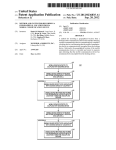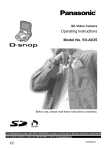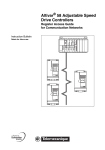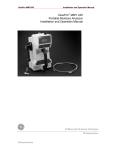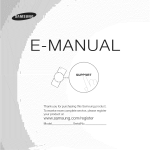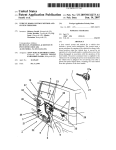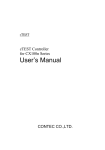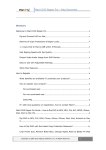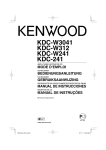Download Sound output control device
Transcript
US008548617B2
(12) United States Patent
Ochi
(54)
US 8,548,617 B2
(10) Patent N0.:
(45) Date of Patent:
SOUND OUTPUT CONTROL DEVICE
Oct. 1, 2013
FOREIGN PATENT DOCUMENTS
JP
JP
JP
(75) Inventor: Hikaru Ochi, Kariya (JP)
2004-118437
2008-283569
2009-021670
4/2004
11/2008
1/2009
(73) Assignee: Denso Corporation, Kariya (JP)
OTHER PUBLICATIONS
(*)
Notice:
Subject to any disclaimer, the term of this
patent is extended or adjusted under 35
U.S.C. 154(b) by 430 days.
Prior Publication Data
US 2010/0274370 A1
(30)
(52)
(57)
(JP) ............................... .. 2009-109151
Int. Cl.
G06F 17/00
US. Cl.
USPC
(58)
(74) Attorney, Agent, or Firm * Harness, Dickey & Pierce,
PLC
Oct. 28, 2010
Foreign Application Priority Data
Apr. 28, 2009
(51)
Primary Examiner * Andrew C Flanders
Assistant Examiner * Alexander Eljaiek
Apr. 27, 2010
(65)
.......................................................... ..
700/94
.............................................. .. 713/1; 700/94
See application ?le for complete search history.
(56)
ABSTRACT
A sound output control device is disclosed. The sound output
control device includes an application information acquisi
tion section and a control section. The application informa
tion acquisition section is con?gured to acquire application
(2006.01)
Field of Classi?cation Search
USPC
cation No. 2009-109151.
* cited by examiner
(21) App1.N0.: 12/799,581
(22) Filed:
Of?ce action dated Apr. 26, 2011 in corresponding Japanese Appli
information from an external device having multiple applica
tions for sound output. The control section is con?gured to
process audio data streamed from the external device through
causing the external device to start one of the multiple appli
cations. The control section has a predetermined selection
criterion to select a start-candidate application from the plu
rality of applications. The control section is further con?g
References Cited
ured to select the start-candidate application according to the
application information acquired from the external device
U.S. PATENT DOCUMENTS
6,898,653 B2*
2007/0140187 Al*
5/2005
Su et al. ...................... .. 710/302
6/2007 Rokusek et al
.. 370/338
2008/0126929 A1 *
5/2008
Bykov
.. 715/700
2008/0168188 Al*
7/2008
Yue etal. ...................... .. 710/15
2009/0015433 A1
1/2009 James et al.
2009/0017813 A1 *
l/2009
....... ..
and the predetermined selection criterion, and cause the
external device to start the selected start-candidate applica
tion.
12 Claims, 7 Drawing Sheets
Yuki ........................... .. 455/419
1
2
i
NE
W K
lN-VEHICLE APPARATUS
CELLULAR PHONE
4
BT
“OOIIIIURIOATIONJ
AVRCP1.4
N6
"'
RECEIVE
/
COMMENICAIPON
N TWOR
DISPLAY
CONTROLLER
12
‘3
I4
OPERATION
i
DISPLAY
STORAGE
<—~.
16
OUTGOING voIOE
INPUT
N10
“
~—>
17
SIGNAL
INCDMING VOICE
INPUT
OUTPUT
1%
l—ACC SIGNAL
1
MEDIA PLAYER
aaaa
2
DIGITAL TV
bbbb
3
RADIO
cccc
A
GAME
dddd
15
9
<—>
INDEX APPLICATION PLAYER ID
COMMUNICATION
,os
——>
CONTROLLER
TELEPHONE
RECEWE
SOUND
OUTPUT
11
BT
COMMUNICATION
9
37.
OPERATION
7
—»
a
l.
i
l
US. Patent
0a. 1, 2013
Sheet 2 of7
@
US 8,548,617 B2
FIG. 2
TRANSMIT DEFAULT PLAYER ID REQUEST “S1
A
NO
32
RECEIVE
DEFAULT PLAYER m
ANSWER?
T’YEs
RECORD DEFAULT PLAYER ID
“83
TRANSMIT APPL. TNFO. REQUEST “v84
RECEIVE
PPL. INEO ANSWE
' YES /\/S6
RECORD APPL. INFO.
HAS
AUDIO FUNCTION?
YES
HAS
YES
HAS
s11
BROWSINGqFUNCTION
' YE
START
3
BROWSINGJUNCTION
YES
W312
APPL
<
516
START-CANDIDATE
YES
APPL. HAS
BROWSING FUNCTION?
-
Wm
START START-CANDIDATE APPL.
@
S15
‘F0
W517
STARTTTREE? é?wcn 0N
US. Patent
0a. 1, 2013
Sheet 3 of7
US 8,548,617 B2
FIG. 3
IN-VEHICLE
APPARATUS
CELLULAR PHONE
COMPLETION OF AVRCP I. 4 CONNECTION PROCEDURE
DEFAULT PLAYER ID REQUEST
DEFAULT PLAYER ID ANsIIIER
APPL. INFO. REQUEST (INDEX 1)
APPL. INFO. ANSWER (INDEX 1)
APPL. INFO. REQUEST (INDEX 2)
APPL. INFO. ANSWER (INDEX 2)
APPL. INFO. REQUEST (INDEX 3)
APPL. INFO. ANsIIIER (INDEX 3)
APPL. INFO. REoUEsT (INDEX 4)
APPL. INFO. ANswER (INDEX 4)
AVRCP 1_ 4
CONNECT'NG
US. Patent
Oct. 1, 2013
Sheet 5 0f 7
.
21g: 3 9%, ma; E88
w
m 2 F32’; Ema mi
_
FLAYER 53%??? .i $452 ‘1?? Wig;
23% i m
w
US 8,548,617 B2
US. Patent
Oct. 1, 2013
US 8,548,617 B2
Sheet 6 of7
i353
saizssmiwi
“M5523
saax
i m E {12% imisa m
2"‘;
ML:
UERAR?
55%.";
am $83“
wag
m? as?
2 "mm.
US 8,548,617 B2
1
2
SOUND OUTPUT CONTROL DEVICE
trol section has a predetermined selection criterion to select a
CROSS REFERENCE TO RELATED
APPLICATION
the start-candidate application being the one of the multiple
applications to be started in the external device. The control
section is further con?gured to select the start-candidate
The present application is based on Japanese Patent Appli
cation No. 2009-109151 ?led on Apr. 28, 2009, disclosure of
application according to the application information acquired
Which is incorporated herein by reference.
criterion, and cause the external device to start the selected
start-candidate application from the plurality of applications,
from the external device and the predetermined selection
start-candidate application.
BACKGROUND OF THE INVENTION
According to the above sound output control device, it is
possible to automatically select a most suitable application to
be started in the external device, it is possible to make user
selection of the most suitable application unnecessary, and it
is possible to optimally process audio data streamed from the
external device.
1. Field of the Invention
The present invention relates to a sound output control
device, Which is con?gured to cause an external device to start
one of applications for sound output, and Which is further
con?gured to process audio data streamed from the external
device.
2. Description of Related Art
In recent years, there has been provided a technique for
streaming audio data (e.g., music data) to an in-vehicle appa
ratus from a modern cellular phone, Which typically has mul
tiple applications such as a media player, a terrestrial digital
TV application, a radio application, a game application and
the like.
JP-2008-283569A discloses a con?guration for connect
ing devices to each other by using Audio/Video Remote Con
trol Pro?le (AVRCP), Which is one of pro?les de?ned in the
Bluetooth (registered trademark, also referred to hereinafter
as BT) communications standards.
The inventor of the present application has studied a con
BRIEF DESCRIPTION OF THE DRAWINGS
20
The above and other objects, features and advantages of the
present invention Will become more apparent from the fol
loWing detailed description made With reference to the
accompanying draWings. In the draWings:
25
FIG. 1 is a functional block diagram illustrating an in
vehicle apparatus and a cellular phone according to one
embodiment;
FIG. 2 is a ?owchart illustrating processes performed by
the in-vehicle apparatus;
FIG. 3 is a sequence diagram illustrating application acqui
30
?guration for connecting devices to each other by using the
sition requests and application acquisition ansWers;
FIGS. 4A to 4C are diagrams each illustrating a WindoW in
AVRCP. Discussion is given beloW on such con?guration as a
related art. It is assumed that an in-vehicle apparatus receives
a case ofAVRCP 1.3;
audio data transferred from a cellular phone. By using the
a case ofAVRCP 1.4;
AVRCP ver. 1.4 (referred to hereinafter as AVRCP 1.4), the
in-vehicle apparatus can acquire application information on
FIG. 5A is a diagram illustrating a unconnection WindoW in
35
multiple applications installed in the cellular phone. HoW
ever, a technique for the in-vehicle apparatus, after acquiring
the application information, to automatically select a most
suitable application to be started in the cellular phone has not
been established. It is thus di?icult for in-vehicle apparatus to
optimally process the audio data streamed from the cellular
FIG. 5B is a diagram illustrating a connection establishing
WindoW in a case of AVRCP 1.4;
FIG. 5C is a diagram illustrating a player starting WindoW
in a case ofAVRCP 1.4;
FIG. 6A is a diagram illustrating a main WindoW in a case
40
ofAVRCP 1.4; and
FIGS. 6B, 6C, 7A to 7C are diagrams each illustrating a
broWse WindoW in a case of AVRCP 1.4.
phone. Moreover, unless the technique for automatically
selecting a most suitable application to be started in the cel
lular phone is not established, a user is required to manually
select the most suitable application. In such cases, operability
45
is disadvantageously loW.
DETAILED DESCRIPTION OF THE
EXEMPLARY EMBODIMENTS
In one embodiment, a sound output control device is
applied to an in-vehicle apparatus that is mounted to a vehicle
and has a BT communication function.
SUMMARY OF THE INVENTION
50
In the folloWings, it is assumed that a BT-supporting cel
lular phone having a BT communication function is carried
into a compartment of the vehicle equipped With the in
vehicle apparatus, and the in-vehicle apparatus and the cellu
tion of the most suitable application unnecessary, and can
55
optimally process audio data streamed from the external
device.
According to a ?rst aspect of the present invention, a sound
output control device includes an application information
acquisition section and a control section. The application
munication link.
As shoWn in FIG. 1, an in-vehicle system 1 includes an
in-vehicle apparatus 2 and a cellular phone 3. The in-vehicle
apparatus 2 includes a controller 4, a BT communication
60
7, a sound output device 8, a storage medium 9 and a signal
input device 10. In the above, the in-vehicle apparatus 2 is an
In vieW of the above and other di?iculties, it is an objective
of the present invention to provide a sound output control
device that can automatically select a most suitable applica
lar phone are communicable With each other via a BT com
tion to be started in an external device, can make user selec
device 5, and an operation reception device 6, a display device
information acquisition section is con?gured to acquire appli
cation information from an external device having multiple
example of a sound output control device, the cellular phone
applications for sound output, the application information
being information on the multiple applications of the external
is an example of an external device, the controller is an
example of a control section or means. The BT communica
tion device 5 is an example of an application information
acquisition section or means, and an example of a communi
device. The control section is con?gured to process audio data
streamed from the external device through causing the exter
nal device to start one of the multiple applications. The con
65
cation link connection section or means.
US 8,548,617 B2
4
3
The cellular phone 3 includes a control part 11, a BT
The controller 4 includes a microcomputer, Which has a
CPU, a RAM, a ROM, an I/ O bus and the like. The controller
4 may control generally all of operations of the in-vehicle
apparatus 2, including a communications operation, a data
management operation and the like. The BT communication
communication part 12, a telephone communication part 13,
an operation reception part 14, a display part 15, an outgoing
voice input part 16 and an incoming voice output part 17. The
5
device 5 has a function to perform BT communications With
controls generally all of operation of the cellular phone 3,
the cellular phone 3. When communicating With the cellular
including a communications operation, a data management
phone 3 via a BT communication link, the BT communication
device 5 can have connection With the cellular phone 3 by
using Audio/Video Remote Control Pro?le ver. 1.4 (AVRCP
1.4) for remote control of audio and/or video. In addition to
the AVRCP 1.4, the BT communication device 5 may have
connectionusing Handsfree Pro?le (HFP) for handsfree com
operation and the like. The control part 11 has multiple appli
cations for sound output, including a media player, a TV
application for mobile terrestrial digital audio/video and data
broadcasting service, a radio application, and a game appli
cation or the like for example. In the above, the TV applica
tion is used for broadcasting directed to a movable or mobile
munication, Phone Book Access Pro?le (PBAP) for phone
object such as a cellular phone and the like. The broadcasting
book data transfer and the like. The BT communication
device 5 may or may not be capable of simultaneously using
may be terrestrial digital media broadcasting. The multiple
applications are registered While indexes and player IDs (ap
plication IDs) are being assigned thereto. The player IDs are
these pro?les to have connection (i.e., multi-connection) With
the cellular phone 3. The above pro?les means communica
tion protocols de?ned based on respective functions. In the
above, the BT communication link is an example of a local
Wireless communication link.
20
mechanical sWitch, a touch sensitive button provided on a
screen of the display device 7, and the like. When detecting a
user operation of the mechanical sWitch, the touch sensitive
button or the like, the operation reception device 6 outputs an
operation detection signal indicative of content of the user
operation to the controller 4, and the controller 4 analyZes the
25
inputted operation detection signal. The display device 7
30
receiving a display control signal from the controller 4, the
35
cation netWork. The operation reception part 14 includes a
embodiment, the display device 7 and the sound output device
40
45
the control part 11 analyZes the operation detection signal.
The display part 15 includes, for example, a liquid crystal
display panel. When receiving a display control signal from
the control part 11, the display part 15 displays variety of
images and WindoWs such as a standby WindoW, an incoming
mail noti?cation WindoW and the like based on the display
50
of the cellular phone 3, With Which the in-vehicle apparatus 2
is communicable via the BT communication link. The signal
input device 10 inputs an accessory signal (ACC signal) from
55
control signal. When the cellular phone 3 is in a telephone
communication state, the outgoing voice inputted via the
outgoing voice input part 16 is processed in a voice process
ing module of the control part 11 to create an outgoing voice,
and the outgoing voice is transmitted via the communication
netWork. The incoming voice received With the telephone
communication part 13 is processed in the voice processing
module of the control part 11 and is outputted from the incom
ing voice output part 17.
the key sWitch is in ON (i.e., high level), the controller 4 cause
Operation of the in-vehicle system 1 is illustrated beloW
the in-vehicle apparatus 2 to be in a poWer-on state so that an
operation poWer is supplied from an in-vehicle battery to
generally all of functional blocks of the in-vehicle apparatus
2 and the in-vehicle apparatus performs normal operation in a
Waking up mode. While the ACC signal from the key sWitch
is in OFF (i.e., loW level), the controller 4 causes the in
reception part 14 outputs an operation detection signal indica
tive of content of the user operation to the control part 11, and
device and sound output device in order to provide the image
a key sWitch to the controller 4. While the ACC signal from
The telephone communication part 13 has a function to
perform Wide area Wireless communications via a communi
keyboard, in Which multiple keys such as a call key, an ansWer
key, a numeric key, a multi-key and the like are arranged.
When detecting a user operation on one of keys, the operation
8 are illustrated as being built in the in-vehicle apparatus 2.
and the touch sensitive button and in order to output the
sound.
The storage medium 9 has storage areas for storing various
data. For example, the storage medium 9 has a storage area for
storing therein a telephone number and a BT device address
1.4 de?ned in BT communications standards. Like the BT
communication device 5 of the in-vehicle apparatus 2, the BT
communication part 12 of the cellular phone 3 may have
connection using the HFP, the PBAP and the like in addition
to the AVRCP 1.4, and the to have the connection, and the BT
communication part 12 of the cellular phone 3 may be or may
not be capable of simultaneously using these pro?les.
display device 7 displays an image on a screen or provides a
touch sensitive button on the screen based on the display
device 8 may be external With respect to the in-vehicle appa
ratus 2. For example, When a display device corresponding to
the display device 7 and a sound output device corresponding
to the sound output device 8 are equipped in the vehicle, the
in-vehicle apparatus 2 may be con?gured to use such display
The BT communication part 12 has a function to perform
BT communications With the in-vehicle apparatus 2. When
communicating With the in-vehicle apparatus 2 via the BT
communication link, the BT communication part 12 can have
connection With the in-vehicle apparatus 2 by using AVRCP
includes, for example, liquid crystal display panel. When
Alternatively, the display device 7 and the sound output
unique on an application-by-application basis. As shoWn in
FIG. 1, the player ID may be “aaaa” Where each “a” is an
arbitrary number.
The operation reception device 6 includes, for example, a
control signal. The sound output device 8 receives a sound
output control signal from the controller 4 and outputs a
sound based on the sound output control signal. In the present
control part 11 includes a microcomputer, Which has a CPU,
a RAM, a ROM, an I/O bus and the like. The control part 11
With reference to FIG. 2 to FIG. 7. FIG. 2 a ?owchart illus
trating processes to be performed by the in-vehicle apparatus
60
2. When the controller 4 of the in-vehicle apparatus 2 deter
mines that, for example, the ACC signal inputted from the key
apparatus 2 and the in-vehicle apparatus 2 performs a loW
sWitch to the signal input device 10 is sWitched from OFF to
ON state, the controller 4 sWitches the in-vehicle apparatus 2
from the sleep mode to the Wake up mode, establishes the BT
communication link betWeen the BT communication device 5
and the cellular phone 3, and starts performing a connection
poWer consumption operation in a sleep mode.
procedure of the AVRCP 1.4. Although the sWitching of the
vehicle apparatus 2 to be in a poWer-off state so that an
operation poWer is supplied from the in-vehicle battery to
limited one or ones of the functional blocks of the in-vehicle 65
US 8,548,617 B2
5
6
ACC signal from OFF to On triggers the start of the connec
(the TV application, the radio application and the game appli
cation) do not have the broWsing function.
tion procedure of the AVRCP 1.4 in the above example, the
start of the connection procedure of the AVRCP 1.4 may be
triggered by another event. For example, the start of the
connection procedure of the AVRCP 1.4 may be triggered by
As shoWn in FIG. 3, When the number of times the cellular
phone 3 has received the application acquisition request from
the in-vehicle apparatus 2 after the ?nish of the connection
procedure of the AVRCP 1.4 is one time, the cellular phone 3
a user manual operation. When ?nishing the connection pro
cedure of the AVRCP 1.4, the controller 4 performs the pro
cess illustrated in FIG. 4 While the connection is made using
the AVRCP 1.4.
At S1, the controller 4 transmits a default player ID acqui
sition request from the BT communication device 5 to the
cellular phone 3. At S2, the controller 4 Waits for the BT
communication device 5 to receive a default player ID acqui
sition ansWer from the cellular phone 3 and determines
Whether the BT communication device 5 receives the default
player ID acquisition ansWer Within a predetermined period
after the transmission of the default player ID acquisition
request. When the cellular phone 3 receives the default player
ID acquisition request from the in-vehicle apparatus 2, the
cellular phone 3 retrieves a player ID of a default application,
transmits, to the in-vehicle apparatus 2, the application acqui
sition ansWer containing the application information on the
application Whose registered index is “1”. When the number
of times the cellular phone 3 has received the application
acquisition request from the in-vehicle apparatus 2 after the
?nish of the connection procedure of the AVRCP 1.4 is tWo
times, the cellular phone 3 transmits, to the in-vehicle appa
ratus 2, the application acquisition ansWer containing the
application information on the application Whose registered
index is “2”.
When the controller 4 determines that the BT communica
tion device 5 receives the application acquisition ansWer from
20
the cellular phone 3 Within the predetermined period after the
transmission of the application acquisition request, the deter
25
mination “YES” is made at SS, and the process proceeds to
S6. At S6, the controller 4 extracts the application information
from the application acquisition ansWer and records the
extracted application information in the storage are of the
storage medium 9. At S7, the controller 4 determines Whether
Which is an application registered as a default at the present
time. Further, the cellular phone 3 transmits to the in-vehicle
apparatus 2 the default player ID acquisition ansWer contain
ing the retrieved player ID as a default player ID.
When the controller 4 determines that the BT communica
tion device 5 receives the default player ID acquisition ansWer
the application information received from the cellular phone
from the cellular phone Within the predetermined period after
the transmission of the default player ID acquisition request,
the determination “YES” is made at S2 and the process pro
ceeds to S3. At S3, the controller 4 extracts the default player
30
ID from the default player ID acquisition ansWer received
from the cellular phone 3, and records the extracted player ID
in the storage area of the storage medium 9.
At S4, the controller 4 causes the BT communication
device 5 to transmit an application acquisition request to the
cellular phone 3. At S5, the controller 4 Waits for the BT
communication device 5 to receive an application acquisition
ansWer and determines Whether the BT communication
device 5 receives the application acquisition ansWer from the
cellular phone Within a predetermined period after the trans
mission of the application acquisition request. When the cel
lular phone 3 receives the application acquisition request
from the in-vehicle apparatus 2, the cellular phone 3 deter
35
40
S9, the controller 4 determines Whether the default player ID
recorded at S3 matches the player ID contained in the appli
cation information recorded at S6, by comparing the default
player ID to the player ID. In the above, the application
45
vehicle apparatus 2 has receives the application information
information recorded at S6 is the latest one When the in
2. Further, the cellular phone 3 retrieves information on an
application (also called application information) that has the
registered index corresponding to the number of times the
cellular phone 3 has received the application acquisition
request from the in-vehicle apparatus 2, as shoWn in FIG. 3.
The retrieved application information includes information
on the player ID of the application, Whether the application
has an audio function, Whether the application has a broWsing
function, or the like. The cellular phone 3 transmits the appli
50
cation acquisition ansWer containing the retrieved application
55
larger than “2”, the determination “NO” is made at S7, and the
data, Which represents music. In the present embodiment, it is
assumed the media player has the audio function but the
60
cation, the radio application and the game application) do not
have the audio function. In this relation, the broWsing func
tion herein is a function of transferring information on all
music, artist, album, play list and the like to the in-vehicle
apparatus 2, as shoWn in FIGS. 6 and 7. In the present embodi
ment, it is assumed that the media player has the broWsing
function but the multiple applications except the media player
multiple times as shoWn in FIG. 3 .I. This is also the case in the
beloW-described processes.
When the controller 4 determines at S7 that the application
information received from the cellular phone 3 is not the
information on the application having the index “1” but the
information on the application having the index equal to or
process proceeds to S9. In this case, the controller 4 does not
information to the in-vehicle apparatus 2.
The audio function herein a function of playback of music
multiple applications except the media player (the TV appli
When the controller 4 determines that the application
information received from the cellular phone 3 is the infor
mation on the application Whose registered index is “1”, the
determination “YES” is made at S7, and the process proceeds
to S8. At S8, the controller 4 records the application having
the index “1” as a start-candidate application in the storage
area of the storage medium 9. In the above, the start-candidate
application is a candidate of an application to be started. At
mines hoW many times the cellular phone 3 has received the
application acquisition request from the in-vehicle apparatus
3 is the information on the application Who se registered index
is “1”. In other Words, the controller 4 may determine Whether
the number of times the in-vehicle apparatus 2 has received
the application acquisition ansWer after the ?nish of the con
nection procedure of the AVRCP 1.4 is one time.
65
record the application as the start-candidate application. At
S9, the controller 4 determines Whether the default player ID
recorded at S3 matches the player ID contained in the appli
cation information recorded at S6, by comparing the default
player ID to the player ID.
When the controller 4 determines that the default player ID
recorded at S3 s identical to and matches the player ID con
tained in the application information recorded at S6, the
determination “YES” is made at S9 and the process proceeds
to S10. At S10, the controller 4 determines Whether the appli
cation corresponding to the player ID recorded at S6 is an
application having the audio function, based on the applica
tion information (e.g., the player ID, the existence or nonex
istence of the audio function) recorded at S6.
US 8,548,617 B2
7
8
When the controller 4 determines that the application cor
responding to the player ID recorded at S6 is an application
controller 4 causes the start-candidate application to be
started. After S13, the processes illustrated in FIG. 2 are
ended.
having the audio function, corresponding to “YES” at S10,
Through the above processes, the in-vehicle apparatus 2
can operate in the folloWing Way. When the application reg
istered in the cellular phone 3 as a default (default applica
tion) has the audio function and the broWsing function, the
in-vehicle apparatus 2 selects the default application and
causes the cellular phone 3 to start the default application.
When the application registered as the default in the cellular
phone 3 is not an application having the audio function and
the broWsing function, the in-vehicle apparatus 2 selects the
the process proceeds to S11. At S11, the controller 4 deter
mines Whether the application corresponding to the player ID
recorded at S6 has the broWsing function, based on the appli
cation information recorded at S6, the application informa
tion including the player ID, the existence or nonexistence of
the broWsing function.
When the controller 4 determines that the application cor
responding to the player ID recorded at S6 has the broWsing
function, corresponding to “YES” at S11, the process pro
ceeds to S12. At S12, the controller 4 records the application
application having a small, registered index in the cellular
phone 3 (i.e., the application having a high priority in the
cellular phone 3) from among the applications having the
corresponding to the player ID recorded at S6 as the start
candidate application. In the above, When one of the applica
tions has been recorded as the start-candidate application at
audio function and the broWsing function, and the in-vehicle
this point, the recorded start-candidate application is over
Written With the application corresponding to the player ID
apparatus 2 causes the cellular phone 3 to start the selected
recorded at S6. At S13, the controller 4 causes the cellular
application.
20
Explanation is given beloW in more detail by using a spe
ci?c example. First, it is assumed that the application regis
phone 3 to start the application corresponding to the start
candidate application, and the processes illustrated in FIG. 2
tered as a default in the cellular phone 3 is the media player,
and the applications to Which indexes are assigned include the
are ended.
the player ID contained in the application information
media player. In this case, since the media player has the
audio function and the broWsing function, the controller 4
records the media player as the start-candidate application in
recorded at S6, the determination “NO” is made at S9, and the
process proceeds to S14. At S14, the controller 4 determines
the storage area and causes the cellular phone 3 to start the
media player, Which is stored at this point as the candidate to
When the controller 4 determines at S9 that the default
player ID recorded at S3 is not identical to or does not match
25
Whether the application corresponding to the player ID
recorded at S6 has the audio function, based on a piece of the
be started. Second, it is assumed that the application regis
30
tered as a default in the cellular phone 3 is other than the
application information recorded at S6, the piece indicating
Whether the applications has the audio function.
media player and is one of the TV application, the radio
When the controller 4 determines that the application cor
responding to the player ID recorded at S6 has the audio
function, corresponding to “YES” at S14, the process pro
ceeds to S15. At S15, the controller 4 determines Whether the
applications to Which the indexes are assigned include the
media player, since the media player has the audio function
and the broWsing function, the controller 4 records the media
player as the start-candidata application in the storage area
application and the game application. In this case, When the
35
application corresponding to the player ID recorded at S6 has
the broWsing function based on a piece of the application
information recorded at S6, the piece indicating Whether the
applications has the broWsing function.
40
and causes the cellular phone 3 to start the media player,
Which is stored as the start-candiadata application.
As seen from the above, When the applications to Which the
indexes are assigned include the media player, the in-vehicle
apparatus 2 can cause the cellular phone 3 to start the media
player and stream the audio data to the in-vehicle apparatus 2,
and the in-vehicle apparatus 2 can process the audio data
45
less of Which indexes are assigned to applications other than
When the controller 4 determines that the application cor
responding to the player ID recorded at S6 has the broWsing
function, corresponding to “YES” at S15, the process pro
ceeds to S16. At S16, the controller 4 determines Whether the
application stored as the start-candidate application at this
point has the broWsing function. When the controller 4 deter
mines that the application stored as the start-candidate appli
cation at this point does not have the broWsing function,
corresponding to “NO” at S16, the process proceeds to S17.
At S17, the application indicated by the application informa
streamed by the media player of the cellular phone 3, regard
the media player.
In the present embodiment, the in-vehicle apparatus 2 per
forms the folloWings in starting the media player. In the
50
tion recorded at S6 is recorded as the start-candidate applica
tion. After S17, the process returns to S4 so the processes S4
and later are repeatedly performed. At S17 also, if one of the
applications has been already stored as the start-target appli
cation at this point, the already stored start-candidate appli
cation is overWritten With the application corresponding to
55
the player ID recorded at S6.
When the controller 4 determines at SS that the BT com
munication device 5 does not receive the application acqui
sition ansWer from the cellular phone 3 Within the predeter
mined period after the transmission of the application
acquisition request, the determination “NO” is made at SS,
and the process proceeds to S18. At S18, the controller 4
determines Whether the start-candidate application is stored
at this point. When the controller 4 determines that the start
candidate application is stored at this point, corresponding to
“YES” at S18, the process proceeds to S13. At S13, the
beloW-described illustrations, a case of AVRCP-1.3-based
connection is compared to a case of AVRCP-l .4-based con
nection. FIG. 4 illustrates display transition in the case of the
AVRCP-1.3-based connection according to a comparison
example. FIGS. 5 to 7 illustrate display transition in the case
of the AVRCP-l .4-based connection according to the present
embodiment.
In the case of the AVRCP-1.3-based connection, as shoWn
in FIG. 4A, the controller 4 can display a unconnection Win
doW 51 on the display device 7 to indicate that a portable
device (e.g., cellular phone) is unconnected With the in-ve
60
hicle apparatus 2. The unconnection WindoW 51 has a “con
nect” button 5111. When the controller 4 determines that the
“connect” button 51a of the disconnection WindoW 51 is
pressed, the controller 4 displays a connection establishing
WindoW 52 on the display device 7 to indicate that the con
65
nection With a portable device is being established, as shoWn
in FIG. 4B. In response to completion ofAVSLC (audio/video
service level connection), the controller 4 displays a main
US 8,548,617 B2
10
application registered as a default (default application) in the
cellular phone 3 has the audio function and the broWsing
function, the in-vehicle apparatus 2 selects the default appli
WindoW 53 on the display device 7 at all, as shown in FIG. 4C.
Thus, after that, a user is generally impossible to perform a
browsing operation.
cation and causes the cellular phone 3 to start the selected
In the case of the AVRCP-l .4-based connection, the con
troller 4 displays a unconnection WindoW 51 on the display
device 7 to indicate that a portable device (e.g., a cellular
default application. Thus, it is possible to preferentially use
the application that is registered as a default in the cellular
phone 3 and that has the broWsing function and the audio
function. It is thus possible to preferentially use the applica
phone) is unconnected With the in-vehicle apparatus 2, as
shoWn in FIG. 5A. The unconnection WindoW 51 has a “con
nect” button 5111. When the controller 4 determines that the
“connect” button 51a of the unconnection WindoW 51 is
tion registered as a default, Which is considered to be most
frequently used in the cellular phone 3.
In the present embodiment, the BT communication device
pressed, the controller 4 displays a connection establishing
5 is connectable With the cellular phone 3 via a local Wireless
communication link, and the BT communication device 5 can
WindoW 52 on the display device 7 to indicate that the con
nection With a portable device is being established, as shoWn
in FIG. 5B. In addition, the controller 4 acquires the applica
tion information from the cellular phone 3, selects and starts
acquire the application information from the external device
via the local Wireless communication link When the BT com
munication device 5 is connected With the external device via
the media player. Then, the controller 4 displays a player
starting WindoW 54 on the display device 7 to indicate that the
media player is being started, as shoWn in FIG. 5C.
In response to completion of AVSLC (audio/video service
level connection), the controller 4 displays a main WindoW 55
the local Wireless communication link. According to the
above con?guration, since the application information, Which
20
on the display device 7, as shoWn in FIG. 6A. The main
WindoW 55 for the AVRCP 1.4 is different from the main
WindoW 53 for the AVRCP l .3 in that the main WindoW 55 for
the AVRCP 1.4 further includes a “play list” button 55a and a
“library” button 55b. After display of the main WindoW 55, a
is information on the application installed in the cellular
phone 3, can be transmitted and received betWeen the in
vehicle apparatus 2 and the cellular phone 3, it is possible to
improve freedom of arrangement of the in-vehicle apparatus
2 and the cellular phone 3.
The predetermined selection criterion includes a ?rst selec
25
tion criterion, Which is such that if the application registered
user can have a merit of an added-value by pressing the “play
as a default in the cellular phone 3 does not have the audio
list” button 55a and the “library” button 55b.
More speci?cally, When the controller 4 determines that the
“library” button 55b of the main WindoW 55 is pressed, the
function or the broWsing function, the in-vehicle apparatus 2
selects the application registered as a top level in the cellular
phone 3 from among the applications having the audio func
tion and the broWsing function, and causes the cellular phone
3 to start the selected application. In the above, the default
controller 4 displays a broWse WindoW 56 for broWse on the
display device 7, as shoWn in FIG. 6B. The broWse WindoW 56
has an “all music” button 56a, an “artist” button 56b, an
“album” button 560 and a “play list” button 56d. When the
controller 4 determines that the “all music” button 56a of the
30
broWse WindoW 56 is pressed, the controller 4 displays a
broWse WindoW 57 for all music on the display device 7, as
shoWn in FIG. 6C. When the controller 4 determines that the
“artist” button 56b of the broWse WindoW 56 is pressed, the
35
controller 4 displays a broWse WindoW 58 for artist on the
display device 7, as shoWn in FIG. 7A. When the controller 4
determines that the “album” button 560 of the broWse WindoW
56 is pressed, the controller 4 displays a broWse WindoW 59
for album on the display device 7, as shoWn in FIG. 7B. When
the controller 4 determines that the “play list” button 56d of
the broWse WindoW 56 is pressed, the controller 4 displays a
broWse WindoW 60 for album on the display device 7, as
application is excluded from the applications having the
audio function and the broWsing function. According to this
con?guration, it is possible to give priority to the application
the applications, except the default application, having the
audio function and the broWsing function.
The above embodiments can be modi?ed and extended in
various Ways, examples of Which are described beloW. In the
40
ratus having a handsfree function, an in-vehicle navigation
apparatus having a navigation function, or a handsfree-sup
45
porting in-vehicle navigation apparatus having both of a
handsfree function and a navigation function. Furthermore, a
sound output control device is not limited to such in-vehicle
apparatuses. For example, a sound output control device may
be applied to an information processing device to be placed or
shoWn in FIG. 7C. Due to the above manners, a user can easily
As described above, according to one embodiment, When
50
installed inside a room. In the above embodiment, an external
55
device is applied to a cellular phone. Alternatively, an external
device may be applied to, a portable information terminal.
Furthermore, an external device is not limited to such portable
devices. For example, an external device may be applied to an
information processing device to be placed or installed inside
apparatus 2 can, establish the connection With the cellular
phone 3 by using AVRCP 1.4 and can acquire the application
information from the cellular phone 3. Further, the in-vehicle
above embodiment, a sound output control device is applied
to an in-vehicle apparatus. Alternatively, a sound output con
trol device may be applied to an in-vehicle handsfree appa
broWse music, artists, albums and playlists.
the cellular phone 3 has the multiple applications for sound
output including the media player, the TV application, the
radio application and the game application, the in-vehicle
that is registered as a top level in the cellular phone 3 among
apparatus 2 can automatically select one of the applications
a room. Furthermore, a sound output control device and an
and causes the cellular phone 3 to start the selected one of the
external device are not limited to the in-vehicle apparatus and
applications. According to this con?guration, it is possible to
the cellular phone but may be information processing devices
omit a user operation of manually selecting a most suitable
to be placed or installed inside a room. In the above embodi
ment, a BT communication link is used to connect the in
application, and it is possible to optimally process the audio
data streamed from the cellular phone 3.
60
vehicle apparatus and the cellular phone, and the application
In this relation, the controller 4 has a predetermined selec
tion criterion to select a start-candidate application from the
multiple applications, the start-candidate application being
the one of the plurality of applications to be started in the
external device. The predetermined selection criterion
includes a ?rst selection criterion, Which is such that if the
65
information is transmitted and received betWeen the in-ve
hicle apparatus and the cellular phone via the BT communi
cation link. Alternatively, the application information may be
transmitted and received betWeen the in-vehicle apparatus
and the cellular phone via Wired communications.A selection
criterion for selection of one of multiple application is not
US 8,548,617 B2
11
12
(i) acquires the application information from the exter
nal device,
(ii) selects the start-candidate application from the plu
rality of applications of the external device according
to the acquired application information and the pre
determined selection criterion, and
limited to a ?owchart illustrated in FIG. 2. For example,
another selection criterion may be used, in Which an applica
tion to Which a high priority is assigned by an in-vehicle
apparatus may be preferentially selected.
While the invention has been described above With refer
ence to various embodiments thereof, it is to be understood
that the invention is not limited to the above described
embodiments and constructions. The invention is intended to
cover various modi?cations and equivalent arrangements. In
(iii) causes the external device to start the selected start
candidate application.
2. The sound output controller of claim 1, Wherein:
When the default application registered as the default in the
addition, While the various combinations and con?gurations
described above are contemplated as embodying the inven
external device does not have at least one of the audio
tion, other combinations and con?gurations, including more,
function and the broWsing function, the control section
less or only a single element, are also contemplated as being
Within the scope of embodiments.
Further, each or any combination of procedures, processes,
selects a top level application as the start-candidate
application and causes the external device to start the top
level application;
steps, or means explained in the above can be achieved as a
the top level application is registered in the external device
softWare section or unit (e.g., subroutine) and/or a hardWare
section or unit (e.g., circuit or integrated circuit), including or
not including a function of a related device; furthermore, the
hardWare section or unit can be constructed inside of a micro
as a top level among a predetermined group of applica
tions;
20
Furthermore, the softWare section or unit or any combina
tions of multiple softWare sections or units can be included in
a softWare program, Which can be contained in a computer
readable storage media or can be installed in a computer via a
tions has the audio function and the broWsing function.
3. The sound output controller of claim 1, further compris
25
communications network.
munication link, Wherein:
30
35
matically acquire application information from the
40
control section alWays automatically selects the default appli
45
output controller comprising:
a control section that is equipped in the subject device, and
50
matically selects the start-candidate application and
55
selected start candidate application;
matically acquire application information from the
in the external device among the plurality of applica
tions, has an audio function and a broWsing function, the
60
cation as the start-candidate application and causes the
external device to automatically start the selected default
application; and
in response to establishment of a connection betWeen the
requiring a user manual operation,
con?gured to process audio data streamed from an exter
nal device through causing the external device to auto
matically start one of a plurality of applications for
sound output, Wherein the plurality of applications are
applications installed in the external device, Wherein the
external device is external to the subject device; and
an application information acquisition section that is
equipped in the subject device, and con?gured to auto
When a default application, Which is registered as a default
subject device and the external device, the sound output
controller of the subject device automatically, Without
cation as the start-candidate When the default application has
the audio and the broWsing function.
7. A sound output controller in a subject device, the sound
information acquisition section from the external
device, the control section of the subject device auto
control section automatically selects the default appli
Which is the information on the plurality of applications
of the external device, from the external device via the
local Wireless communication link.
4. The sound output controller of claim 1, Wherein:
the broWsing function is a function of transferring infor
mation on tracks, artist, album and play list.
5. The sound output controller of claim 1, Wherein:
the subject device is an in-vehicle navigation apparatus in
a vehicle; and
the external device is a cellular phone carried in the vehicle.
6. The sound output controller of claim 1, Wherein the
application information acquired by the application
causes the external device to automatically start the
When the communication link connection section is con
nected With the external device via the local Wireless
communication link, the application information acqui
sition section acquires the application information,
a control section that is equipped in the subject device, and
con?gured to process audio data streamed from an exter
nal device through causing the external device to auto
matically start one of a plurality of applications for
sound output, Wherein the plurality of applications are
applications installed in the external device, Wherein the
external device is external to the subject device; and
an application information acquisition section that is
equipped in the subject device, and con?gured to auto
external device, Wherein the application information is
information on the plurality of applications installed in
the external device, Wherein:
the control section of the subject device is provided With a
predetermined selection criterion to automatically select
a start-candidate application from the plurality of appli
cations of the external device, the start-candidate appli
cation being the one of the plurality of applications that
is to be automatically started in the external device;
according to the predetermined selection criterion and the
ing:
a communication link connection section that is connect
able With the external device via a local Wireless com
What is claimed is:
1. A sound output controller in a subject device, the sound
output controller comprising:
the predetermined group of applications is a part of the
plurality of applications of the external device; and
each application in the predetermined group of applica
computer.
65
external device, Wherein the application information is
information on the plurality of applications installed in
the external device, Wherein:
the control section of the subject device is provided With a
predetermined selection criterion to automatically select
a start-candidate application from the plurality of appli
cations of the external device, the start-candidate appli
cation being the one of the plurality of applications that
is to be automatically started in the external device;
US 8,548,617 B2
14
13
according to the predetermined selection criterion and the
9. The sound output controller of claim 8, Wherein:
application information acquired by the application
When a default application, Which is registered as a default
information acquisition section from the external
device, the control section of the subject device auto
matically selects the start-candidate application from the
plurality of applications of the external device and
in the external device among the plurality of applica
tions, has the broWsing function and the music playback
function, the control section of the subject device selects
causes the external device to automatically start the
and causes the external device to start the selected
the default application as the start-candidate application
default application; and
selected start candidate application; and
When the default application, Which is registered as the
in response to establishment of a connection betWeen the
default in the external device, does not have at least one
subject device and the external device, the sound output
controller of the subject device automatically, Without
of the broWsing function and the music playback func
tion, the control section of the external device selects one
requiring a user manual operation,
application having the broWsing function and the music
(i) acquires the application information from the exter
nal device,
(ii) selects the start-candidate application from the plu
rality of applications of the external device according
to the acquired application information and the pre
determined selection criterion, and
playback function as the start-candidate application
from the plurality of applications except the default
application and causes the external device to start the
selected start-candidate application.
(iii) causes the external device to start the selected start
candidate application.
8. The sound output controller of claim 7, Wherein:
according to the predetermined selection criterion, the con
trol section of the subject device selects one application
having a broWsing function and a music playback func
tion as the start-candidate application from the plurality
of applications, and thereafter, the control section causes
the external device to start the start-candidate applica
tion having the broWsing function and the music play
back function.
20
25
10. The sound output controller of claim 7, Wherein:
the broWsing function is a function of transferring infor
mation on tracks, artist, album and play list.
11. The sound output controller of claim 7, Wherein:
the subject device is an in-vehicle navigation apparatus in
a vehicle; and
the external device is a cellular phone carried in the vehicle.
12. The sound output controller of claim 7, Wherein the
control section alWays automatically selects the default appli
cation as the start-candidate When the default application has
the audio and the broWsing function.
*
*
*
*
*















